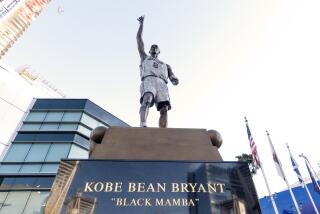The Muumuu’s Image Flaws May Be Too Big to Alter
These days, Oscar Alcaindo is saying, the muumuu business is not too good. Oh, it’s not the muumuus themselves, you understand, but the apparel industry in general. Lousy. People aren’t buying clothes, they’re not buying muumuus.
Oscar has talked with others in the business--not the muumuu business, of course, because Oscar doesn’t know anybody else in the muumuu business--but in the clothing industry as a whole. And that’s what they tell him.
“They’re not doing too hot,” he says.
Oscar pauses. Then he gives me a look. OK, he knows it’s true. Muumuus have an image problem. Which is why Oscar called me in the first place. I was wondering in a recent column about what ever happened to muumuus.
The last time I remember seeing a muumuu was about 15 years ago, on a friend of my mother who was pregnant with her third child--but nobody ever suspected until she came home from the hospital with an infant.
Don’t get me wrong. This was a wonderful woman, a very large, wonderful woman. If you catch my drift.
Oscar does. He nods his head and smiles. Wistfully.
Those were the days. The ‘70s. Back then, Oscar and his wife, Alex--the other half of Oscar and Alex Fashions in Fullerton--were relatively new to the business, and their sewing machines were running almost nonstop.
“We were selling to Sears, J.C. Penney, Lane Bryant, Mervyn’s, all kinds of stores,” Oscar says. “One time, we were on vacation in Hawaii, and we decided to go into Sears, and we saw some muumuus that looked like ours, so we looked at the label, and they were ours. So even in Hawaii, they know our muumuus.”
Of course, things have slowed down considerably since then.
Now it’s just Oscar and Alex doing everything, making patterns, cutting, sewing and selling out of their retail shop in front. About three years ago, they branched out into men’s Hawaiian shirts, made of muumuu fabrics. Children’s sizes they’ll make to order. Prices are very reasonable, most of them under $30.
You do what you can. Not everyone wants muumuus these days.
It’s the times, Oscar says.
“I see people on the street, I tell my wife, ‘That person should be wearing a muumuu.’ But you can’t tell these people that. They don’t want to know. They follow the new styles, the new look, and they don’t care how they are going to look on them. Old ladies dressing like teen-agers. Fat people in T-shirts. Can you tell them? You cannot.”
Oscar himself is not clothed in muumuu fabric. He’s natty in a pink polo shirt, white polyester pants, white socks and shoes. But then he changes into a Hawaiian shirt, saying that for his customers he makes them a little wider through the waist.
The mailman walks into the shop and hands Oscar a packet of envelopes.
“Hey, nice shirt ,” the mailman says. Smirking.
Oscar laughs, sort of.
“That guy, he’s a clown,” Oscar says.
Alex, meanwhile, is dressed in a muumuu, a slimmer version of the off-the-rack styles, with a belt. Back home in Chile, from where she and Oscar emigrated in 1971, the couple had never seen such festive garb. And to this day, as far as the Alcaindos know, Chileans are still in the dark about muumuus.
“It might be a hot item to introduce in Chile,” Oscar says.
But without much conviction.
“The business started changing when the competition from the Orient came in,” he goes on. “The department stores, they could get muumuus cheaper in the Orient. Labor costs are less. But the quality and the fitting is not the same.”
“Fitting?” I ask.
Muumuus are not fitted. Muumuus are shoulder seams, a yoke, maybe a ruffle or two along the bottom if you’re talking fancy. They are very loose. Which, of course, is the whole point.
So Oscar looks at me with the bemused look of one about to impart great wisdom to a particularly dense newcomer, in this case, to the muumuu business.
“Yeah, fitting,” he says. “In the Orient, they are littler. The clothes, they’re smaller. Not like the ones made here. That’s why ladies come in saying they wear a 3X.”
“Three X?” I interrupt.
“Yeah, yeah,” Oscar says. “Three extra large. But I tell them, ‘You can get away with one X.’ They say, ‘No way! I’ve been wearing 3X.’ But I show them. I say, ‘Here, try this.’ And it fits perfectly . Well, can you imagine? Going from 3X to 1X. Wow! And I haven’t even gone on a diet. They love it!”
Well, of course they do. Oscar is a very personable fellow. He knows his muumuus--which were at the zenith of their popularity in Southern California during the early ‘60s--and his customers. And after 17 years in the business, Oscar’s got all sorts of theories about both.
“The first thing you notice is the way someone dresses,” he says. “If I see a lady, no matter how fat, if she is wearing a T-shirt, she is not a muumuu person. . . . Or else, she would wear one only indoors. She’d never be caught on the street with one.”
Which, in Oscar’s estimation, is a crying shame.
“We are so conscious of our looks,” he says. “Especially in Orange County. People think they have to wear the same as the neighbor, look the same and drive the same kind of car. We should stop worrying so much about our looks and start worrying about our comfort.”
And start wearing muumuus. If Oscar does say so himself.
More to Read
Inside the business of entertainment
The Wide Shot brings you news, analysis and insights on everything from streaming wars to production — and what it all means for the future.
You may occasionally receive promotional content from the Los Angeles Times.










